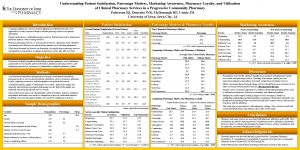Understanding Patient Satisfaction Patronage Motives Marketing Awareness Pharmacy

- Slides: 1

Understanding Patient Satisfaction, Patronage Motives, Marketing Awareness, Pharmacy Loyalty, and Utilization of Clinical Pharmacy Services in a Progressive Community Pharmacy Patterson BJ, Doucette WR, Mc. Donough RP, Urmie JM University of Iowa, Iowa City, IA Introduction • • Patient Satisfaction Consumer adoption of a service-oriented pharmacy model has been slow. Two approaches to study consumer adoption include patronage motives and patient satisfaction. Overall Patient Satisfaction (Selected Items) Patient satisfaction is a multidimensional construct that has been used to characterize pharmacy patrons, often as being satisfied. Professionalism of the pharmacy staff 228 Pharmacy services overall 227 Item Pharmacy patronage motives, or reasons patrons choose a pharmacy, have identified convenience and efficiency as salient factors patients use in selecting pharmacies. While most literature has focused on dispensing, one might expect patronage motives and satisfaction expectations to change as pharmacy service-mix shift over time. Objective • Describe and identify significant relationships amongst pharmacy service utilization, general and service-specific patient satisfaction, pharmacy patronage motives, and marketing awareness in a progressive, independent community pharmacy setting. Methods • • • A self-reported satisfaction questionnaire assessing overall patient satisfaction, patronage motives, service-specific patient satisfaction, service awareness, pharmacy loyalty, marketing awareness, and demographics was piloted and revised. A stratified random sample of 500 patients was created. Half of the sample was randomly selected from prescription dispensing records. Half of the sample was randomly selected using clinical service records. Open-ended survey items were thematically coded. Descriptive statistics, including percentages and means, were used for completion of aim one. Inferential statistics, including t-tests and chi-square statistics were used for completion of aim two. Sample Demographics Respondents Poor Privacy of your conversations with the pharmacist Pharmacist's efforts to help you improve health Availability of the pharmacist to answer questions 0. 0 Fair Good Very Good Excellent 0. 4 28. 9 67. 1 3. 5 0. 9 5. 7 22. 9 70. 5 Respondents Percentage Mean 210 Top 3 Reported Patronage Motives Aware of marketing Not aware of marketing Service Aware Service Unaware Patronage Motive Percentage 2. 4 6. 2 14. 8 31. 4 45. 2 192 1. 0 224 221 Amount of time the pharmacist offers to spend with you 209 Pharmacist's efforts to assure that your meds work for you 193 0. 0 0. 5 2. 1 21. 4 0. 4 6. 3 0. 9 4. 8 4. 1 5. 4 12. 9 13. 0 35. 4 29. 9 33. 5 35. 2 40. 1 67. 9 63. 3 48. 3 47. 2 43. 6 Dispensing 53. 9 0. 9 45. 2 0. 0 Convenience 28. 2 Compounding 36. 9 11. 9 21. 2 18. 0 Ownership 15. 4 Influenza Vacc 53. 5 1. 4 40. 1 4. 6 H Zoster Vacc 22. 6 29. 5 14. 7 27. 2 Pneumoc Vacc 38. 2 14. 7 27. 2 14. 7 Chol Screening 37. 8 14. 7 21. 2 20. 7 Dur Med Equip 41. 0 11. 1 28. 6 13. 8 Adherence Pkg 19. 4 25. 8 16. 6 21. 2 Comparing Patronage Motive and Pharmacy Utilization Patronage Motive Without Motive Relationships 18. 4 14. 6 Convenience 16. 3 16. 6 Ownership 16. 0 16. 6 5. 7 17. 8 Atmosphere 21. 8 16. 0 Competency 16. 6 16. 5 Reputation 15. 8 16. 6 Referral 17. 7 16. 5 Wait Time 12. 8 16. 6 Past Experiences 25. 2 16. 2 Unique Service n = 217; values represent percentages; x 2 p-value < 0. 05 Discussion n = 219; t-test p-value < 0. 05 How well the pharmacist answers your questions 223 0. 0 0. 9 4. 9 28. 3 65. 9 Promptness of prescription service 220 0. 0 5. 9 31. 8 62. 3 Service-specific Patient Satisfaction Patronage Motive Without Motive Relationships 20. 3 20. 8 27. 9 31. 0 Convenience 13. 7 27. 4 17. 8 41. 1 92. 5 87. 6 3. 73 Ownership 4. 5 36. 5 12. 2 46. 7 Compounding 53. 5 13. 7 3. 57 Unique Service 7. 6 33. 5 2. 0 56. 9 Influenza Vaccination 87. 1 53. 1 3. 67 Atmosphere 2. 0 39. 1 8. 1 50. 8 Herpes Zoster Vacc 34. 9 10. 4 3. 56 Competency 1. 0 40. 1 6. 6 52. 3 Pneumococcal Vacc 61. 0 14. 1 3. 76 Reputation 3. 0 38. 1 3. 6 55. 3 Cholesterol Screening 54. 4 5. 0 3. 10 Referral 2. 5 38. 6 3. 0 55. 8 65 Durable Med Equip 64. 3 13. 3 3. 53 Wait Time 0. 5 40. 6 3. 6 55. 3 50 Adherence Packaging 34. 0 15. 4 3. 71 Past Experiences 1. 5 39. 6 2. 0 56. 9 Female 145 64 Chronic diseases present 186 82 Number of prescriptions in last 30 days 215 4. 8 Number of OTCs in last 30 days 220 1. 3 Annual household income >75 k 117 47 Highest education is at least a college degree 148 Aware of marketing efforts 114 n = 241; values represent percentages; a 0 = poor through 4 = excellent Respondents were mostly satisfied. Significant associations with pharmacy loyalty were found with patronage motives, including relationships, quality previous experience, pharmacy atmosphere, personnel competency and unique services. • While some argue that performing unique services should bring more customers in for other services providing transfer business, this may not be the case. • Specific service awareness appeared to be influenced through marketing efforts, such as influenza vaccinations, cholesterol screenings, and adherence packing. • Pharmacists could continue offering unique services but must go further in establishing relationships and demonstrating competency. Pharmacists should be very disciplined in marketing efforts via television and radio as these seem to only increase awareness and not utilization. • This study may not generalize to other pharmacy settings. Also, selection, recall and social-desirability biases may influence the results of this study. Did not visit another pharmacy Dispensing 68. 6 Avg Satisfactiona Visited another pharmacy Utilization 220 • Comparing Patronage Motive and Pharmacy Loyalty Awareness Age Service Relationships Average Times Visited Study Pharmacist's ability to advise you about med problems Service Marketing Awareness n = 219; values represent percentages values reported as percentages Variable Patronage Motives & Pharmacy Loyalty n = 197; values represent percentages; x 2 p-value < 0. 05 Conclusions • Pharmacy patronage motives are associated with pharmacy utilization and loyalty. Most associations are positive between presence of patronage motive, utilization, and loyalty. However, there is evidence that shopping for unique services, such as vaccinations, may be negatively associated with pharmacy loyalty. Acknowledgements • Financial support was provided through a grant from the Community Pharmacy Foundation: A Comprehensive Longitudinal Assessment of an Innovative Community Pharmacy Practice Grant #103, PI: Mc. Donough RP. • Student Pharmacists Zainab Khan and Megan Mormann assisted in data analysis.

